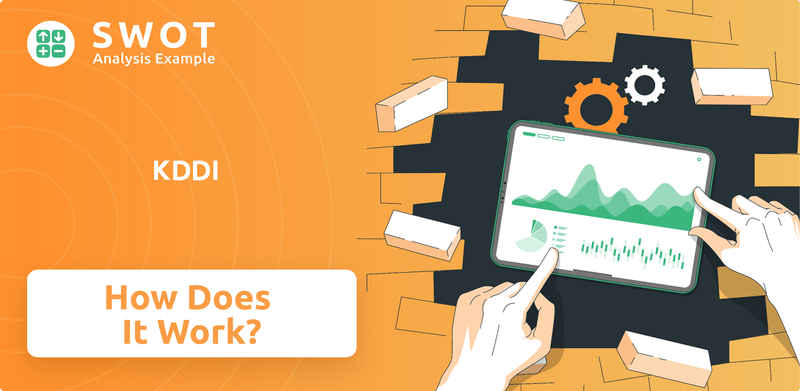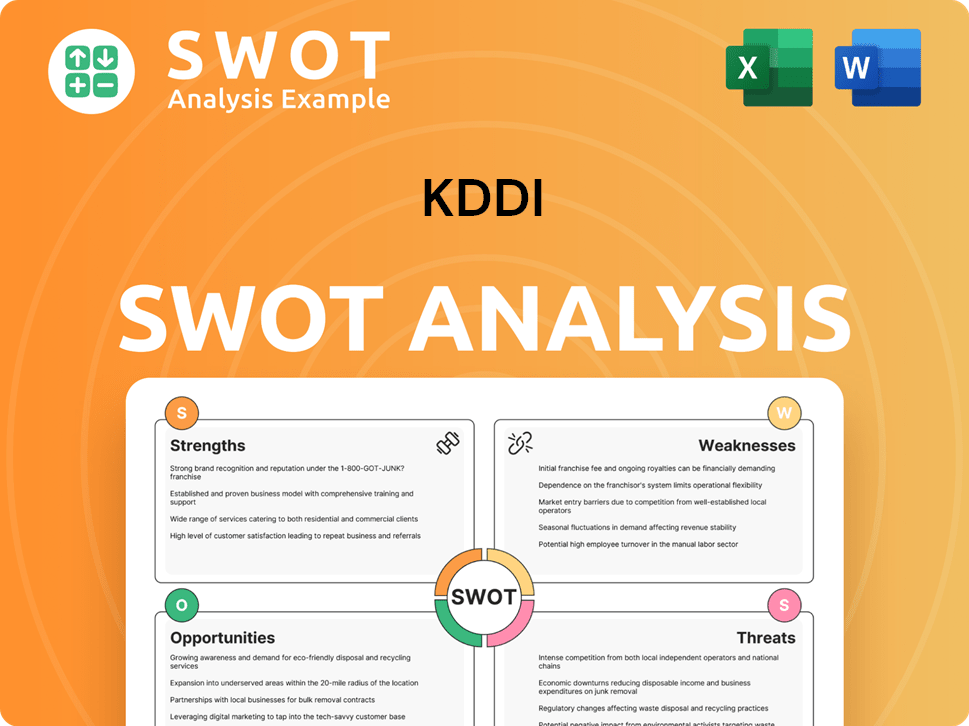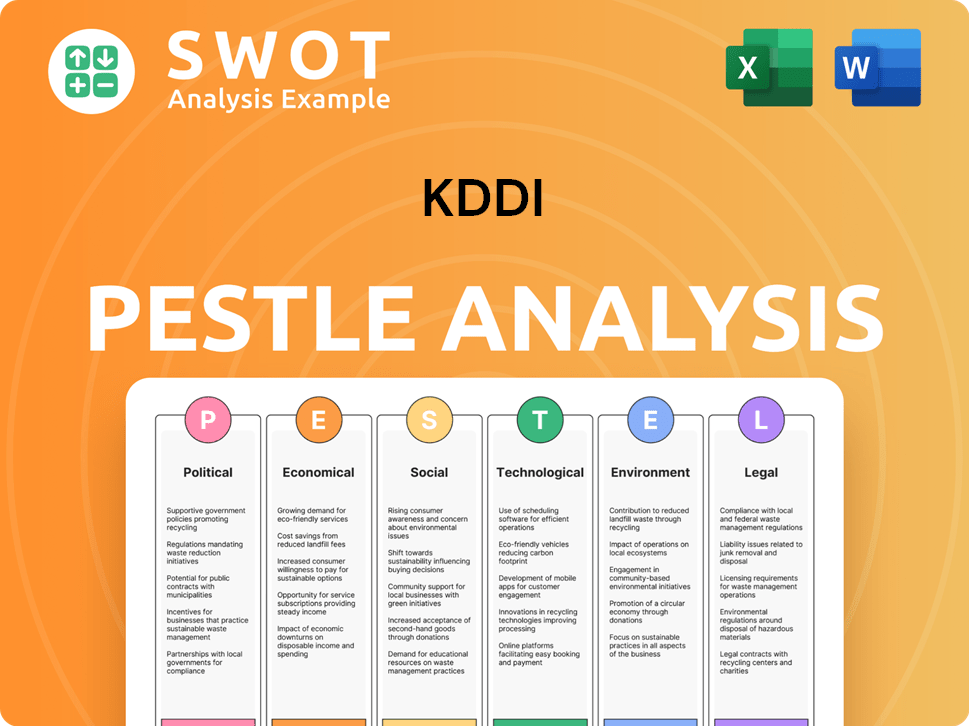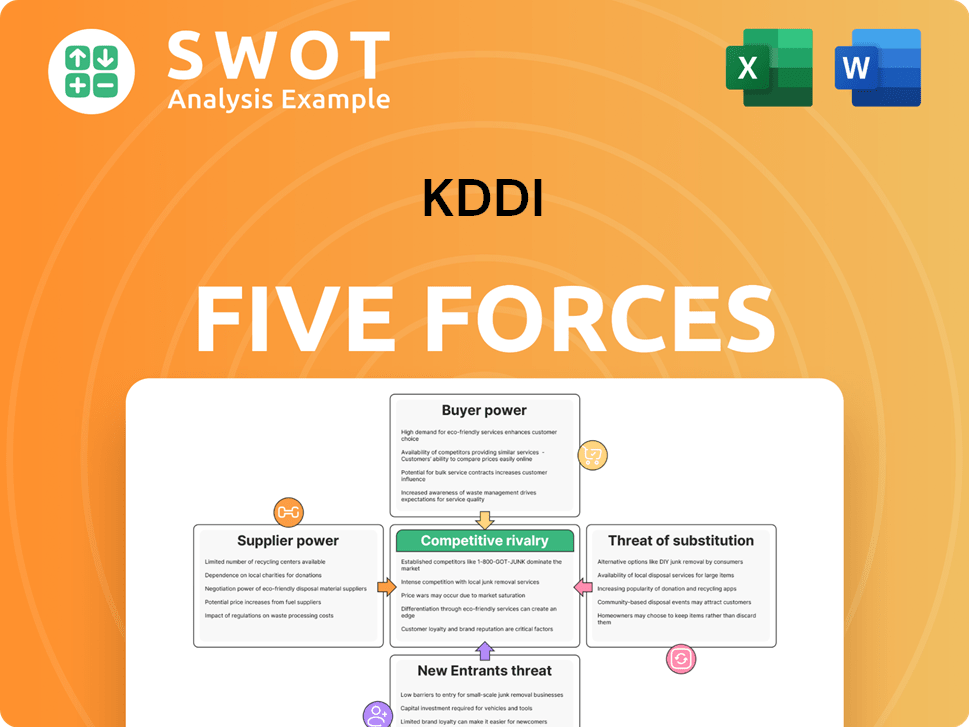KDDI Bundle
Unpacking KDDI: How Does This Telecom Titan Thrive?
KDDI Company, a powerhouse in the Japanese telecommunications sector, recently reported impressive financial results, with a 2.8% revenue increase to approximately $38.1 billion USD for the fiscal year ending March 2025. Its operating income surged by 16.3%, signaling strong financial health. But what fuels this success? This article dives deep into KDDI operations.

From its 'au' mobile services to its expanding ICT solutions, KDDI services are integral to Japan's digital landscape. Understanding KDDI SWOT Analysis can provide insights into its competitive positioning. This exploration will uncover KDDI's core value propositions and strategic moves, offering a comprehensive view of a company shaping the future of Telecom Japan. We'll examine how KDDI Company navigates the evolving demands of the digital age, exploring its diverse revenue streams and its role in 5G deployment in Japan, alongside its customer service contact information.
What Are the Key Operations Driving KDDI’s Success?
KDDI Company, a prominent player in the Japanese telecommunications sector, generates value through a broad spectrum of services. Its core operations revolve around providing comprehensive telecommunications and technology solutions to both individual consumers and corporate clients. This includes mobile communications, fixed-line services, and CATV offerings, all designed to meet diverse communication needs.
The company's value proposition centers on delivering reliable connectivity and innovative digital services. By leveraging its advanced infrastructure and strategic partnerships, KDDI aims to enhance customer experience and expand its service offerings. This integrated approach ensures that customers benefit from a range of lifestyle-oriented solutions, solidifying KDDI's position in the market.
KDDI offers mobile communication services under brands like 'au,' 'UQ mobile,' and 'povo.' These brands cater to different customer segments, providing a variety of plans and services to meet individual needs. The mobile network coverage in Japan is extensive, ensuring reliable connectivity for users across the country.
Fixed-line communication services include fiber-to-the-home (FTTH), voice communication, and data transmission. These services provide high-speed internet and reliable voice solutions for homes and businesses. KDDI continues to invest in its fixed-line infrastructure to meet the growing demand for bandwidth.
Under the 'KDDI BUSINESS' brand, the company provides ICT solutions, data center services, and internet services to corporate clients. These services are designed to support businesses of all sizes with their technology and communication needs. KDDI's focus on corporate clients is a key part of its business model.
KDDI also offers CATV (cable television) services, providing a wide range of entertainment and information channels to households. This service complements its other offerings, creating a comprehensive suite of communication and entertainment solutions. The company continually updates its CATV offerings to stay competitive.
KDDI's operational strategy emphasizes a 'Communication + Value-added' approach, expanding into adjacent businesses. This involves significant investments in 5G and AI infrastructure. The company's commitment to innovation is evident through its strategic partnerships and technology deployments.
- 5G Network Expansion: Completed 94,000 5G base stations by March 2024, aiming for 100,000 by FY 2030.
- AI Infrastructure: Plans to build large-scale AI data centers and establish edge infrastructure across Japan. In March 2025, a partnership with AI Dynamics was announced to deliver advanced AI and machine learning solutions.
- Supply Chain and Partnerships: Collaboration with DriveNets, announced in May 2025, to accelerate the adoption of open network architecture.
- Satellite Growth Strategy: Integration of core telecommunications with finance, energy, and retail, enhancing customer lifetime value.
KDDI's multi-brand strategy and focus on customer experience are central to its operational uniqueness. By leveraging advanced technologies and strategic partnerships, the company provides reliable connectivity and innovative digital services, as detailed in Owners & Shareholders of KDDI. This approach enhances customer satisfaction and drives long-term value.
KDDI SWOT Analysis
- Complete SWOT Breakdown
- Fully Customizable
- Editable in Excel & Word
- Professional Formatting
- Investor-Ready Format

How Does KDDI Make Money?
The KDDI Company generates revenue through a diverse range of services, categorized into Personal Services, Business Services, and Others. For the fiscal year ending March 2025, KDDI reported consolidated revenue of 5,918.0 billion JPY, reflecting a 2.8% year-over-year increase. The company anticipates consolidated operating revenue of 6,330.0 billion JPY for the fiscal year ending March 31, 2026, indicating a 7.0% year-on-year growth.
This growth is fueled by strategic monetization strategies, including bundled services and tiered pricing for mobile plans. KDDI also focuses on cross-selling its 'Life Design' services to its communication subscribers, expanding its reach into finance, energy, commerce, and entertainment sectors. Furthermore, the company is investing in AI infrastructure and digital transformation initiatives to drive future revenue growth.
The Japanese telecommunications giant's success is rooted in its ability to adapt and innovate within a competitive market. Understanding KDDI's operations and financial performance is crucial for investors and stakeholders alike. For a broader view of the competitive landscape, consider exploring the Competitors Landscape of KDDI.
Key revenue streams for KDDI include mobile communications, fixed-line communications, internet services, business services, life design services, and IoT connections. The company's multi-brand strategy, encompassing 'au,' 'UQ mobile,' and 'povo,' caters to diverse customer segments. The enterprise solutions segment generated approximately ¥200 billion (about $1.8 billion) in revenue in 2022 and is projected to grow significantly.
- Mobile Communications: A core revenue driver, with communications ARPU showing an upward trend.
- Fixed-line Communications and Internet Services: Provides FTTH services, voice communications, and data transmission.
- Business Services (DX and ICT Solutions): Includes IoT-related services, data centers, and Digital BPO. The Business Services segment's operating revenue was 333.4 billion JPY in the first quarter of FY25-03, up 16.3% year-over-year.
- Life Design Services: Expanding into finance, energy, commerce, and entertainment. The financial and energy businesses combined contributed an increase of JPY 17.7 billion in operating income for the fiscal year ended March 2025.
- IoT Connections: Cumulative IoT connections reached 44.16 million by the first quarter of FY25-03, with a CAGR of 29.8%.
KDDI PESTLE Analysis
- Covers All 6 PESTLE Categories
- No Research Needed – Save Hours of Work
- Built by Experts, Trusted by Consultants
- Instant Download, Ready to Use
- 100% Editable, Fully Customizable

Which Strategic Decisions Have Shaped KDDI’s Business Model?
The KDDI Company, a major player in Japanese telecommunications, has a history marked by strategic mergers and technological advancements. Formed in 2000 through the consolidation of DDI Corporation, KDD Corporation, and IDO Corporation, KDDI quickly became a comprehensive telecom operator in Japan. This initial move set the stage for its evolution into a leading provider of integrated services, including fixed-line, international, and mobile communications.
Strategic initiatives have been central to KDDI's growth, particularly its focus on 5G network expansion and the development of its mid-term management strategy (FY2022-2025), updated in May 2024. This strategy, aligned with 'KDDI VISION 2030,' aims to achieve sustainable growth through investments in advanced technologies and expanding its service offerings. These moves reflect KDDI's commitment to adapting to the fast-paced telecommunications market.
KDDI's competitive edge is built on its robust infrastructure and innovative service offerings. The company's dedication to 5G deployment and its partnerships, such as the collaboration with SpaceX's Starlink, highlight its proactive approach to meeting evolving customer needs. By focusing on these areas, KDDI continues to strengthen its position in the competitive Japanese telecom market.
KDDI was established in 2000 through the merger of DDI Corporation, KDD Corporation, and IDO Corporation. By March 2024, KDDI had completed the deployment of 94,000 5G base stations. In April 2025, KDDI began offering satellite communication services through a partnership with SpaceX's Starlink.
KDDI updated its mid-term management strategy (FY2022-2025) in May 2024, focusing on 'KDDI VISION 2030' for sustainable growth. The company has adopted a multi-brand strategy, including au, UQ mobile, and povo, to cater to diverse customer needs. Investments in AI infrastructure, including data centers and edge infrastructure, are also underway.
KDDI's brand strength, especially with the 'au' brand, is a key advantage. Its 'Life Design' services ecosystem enhances customer loyalty. The company focuses on open innovation and partnerships, such as with DriveNets and AI Dynamics, to strengthen its position. KDDI aims to achieve carbon neutrality by 2030, supporting its corporate image.
KDDI's operations include a wide range of services, from mobile and fixed-line communications to internet access and data centers. The company's focus on 5G deployment and AI integration highlights its commitment to technological advancement. KDDI's multi-brand strategy allows it to target various customer segments effectively.
KDDI is actively deploying 5G networks, aiming for 100,000 base stations by FY2030, enhancing its network coverage. The company is investing in AI infrastructure, including large-scale AI data centers and edge infrastructure. KDDI is also developing 'WAKONX,' a new business platform for the AI era, to accelerate digital transformation for its corporate clients.
- Partnerships: KDDI collaborates with companies like SpaceX (Starlink), DriveNets, and AI Dynamics to enhance its service offerings and technological capabilities.
- Sustainability: KDDI is committed to achieving carbon neutrality by 2030 and invests in renewable energy projects.
- Customer-Centric Approach: KDDI's multi-brand strategy (au, UQ mobile, povo) and 'Life Design' services aim to meet diverse customer needs and enhance customer lifetime value.
- Innovation: KDDI focuses on open innovation and strategic partnerships to strengthen its competitive position and adaptability in the rapidly evolving telecom market.
KDDI Business Model Canvas
- Complete 9-Block Business Model Canvas
- Effortlessly Communicate Your Business Strategy
- Investor-Ready BMC Format
- 100% Editable and Customizable
- Clear and Structured Layout

How Is KDDI Positioning Itself for Continued Success?
The KDDI Company holds a strong position in the Japanese telecommunications market, ranking as the second-largest mobile carrier. The company also leads in pay-TV and fiber-to-the-home broadband services. Its global network is supported by an extensive submarine fiber optic cable system.
However, KDDI operations face risks such as intense price competition, rapid technological changes, and regulatory shifts. The increasing demand for network infrastructure due to AI and growing internet traffic requires continuous significant investment. These factors can impact the company's financial performance and its ability to maintain market share.
In the Japanese telecommunications sector, KDDI stands as the second-largest mobile carrier, holding approximately a 30% market share. It is also the leading pay-TV operator with a 53% market share and the second-largest provider of fiber-to-the-home broadband, holding a 12% market share. The company's global reach is supported by over 500 international submarine fiber optic cables.
Key risks for KDDI services include intense price competition, rapid technological advancements, and new services from competitors. Regulatory changes and potential market downturns also pose risks. The growing demand for network infrastructure due to AI and increasing internet traffic necessitates substantial and continuous investment.
Looking ahead, KDDI focuses on strategic initiatives to sustain and expand its profitability. The company aims to achieve its EPS targets by March 2026 through its 'Satellite Growth Strategy,' which involves increasing profits in key businesses. KDDI plans to invest ¥100 billion (around $900 million) in renewable energy projects by 2024 and targets carbon neutrality by 2030. The company is also investing in AI infrastructure.
KDDI projects consolidated operating revenue of 6,330.0 billion JPY and an operating income of 1,178.0 billion JPY for the fiscal year ending March 31, 2026. This optimistic outlook demonstrates the company's commitment to growth. The company's forward-looking strategy adapts to evolving market needs and technological advancements.
The company is focused on its 'Satellite Growth Strategy' to increase profits in key areas like ARPU revenues and digital transformation (DX). This includes investments in new areas such as drones and collaborations with Lawson. KDDI is also heavily investing in AI infrastructure and renewable energy projects, demonstrating a commitment to sustainable growth and technological advancement.
- Focus on increasing ARPU revenues.
- Digital transformation (DX) initiatives.
- Investment in AI infrastructure.
- Commitment to renewable energy projects.
KDDI Porter's Five Forces Analysis
- Covers All 5 Competitive Forces in Detail
- Structured for Consultants, Students, and Founders
- 100% Editable in Microsoft Word & Excel
- Instant Digital Download – Use Immediately
- Compatible with Mac & PC – Fully Unlocked

Related Blogs
- What are Mission Vision & Core Values of KDDI Company?
- What is Competitive Landscape of KDDI Company?
- What is Growth Strategy and Future Prospects of KDDI Company?
- What is Sales and Marketing Strategy of KDDI Company?
- What is Brief History of KDDI Company?
- Who Owns KDDI Company?
- What is Customer Demographics and Target Market of KDDI Company?
Disclaimer
All information, articles, and product details provided on this website are for general informational and educational purposes only. We do not claim any ownership over, nor do we intend to infringe upon, any trademarks, copyrights, logos, brand names, or other intellectual property mentioned or depicted on this site. Such intellectual property remains the property of its respective owners, and any references here are made solely for identification or informational purposes, without implying any affiliation, endorsement, or partnership.
We make no representations or warranties, express or implied, regarding the accuracy, completeness, or suitability of any content or products presented. Nothing on this website should be construed as legal, tax, investment, financial, medical, or other professional advice. In addition, no part of this site—including articles or product references—constitutes a solicitation, recommendation, endorsement, advertisement, or offer to buy or sell any securities, franchises, or other financial instruments, particularly in jurisdictions where such activity would be unlawful.
All content is of a general nature and may not address the specific circumstances of any individual or entity. It is not a substitute for professional advice or services. Any actions you take based on the information provided here are strictly at your own risk. You accept full responsibility for any decisions or outcomes arising from your use of this website and agree to release us from any liability in connection with your use of, or reliance upon, the content or products found herein.